-
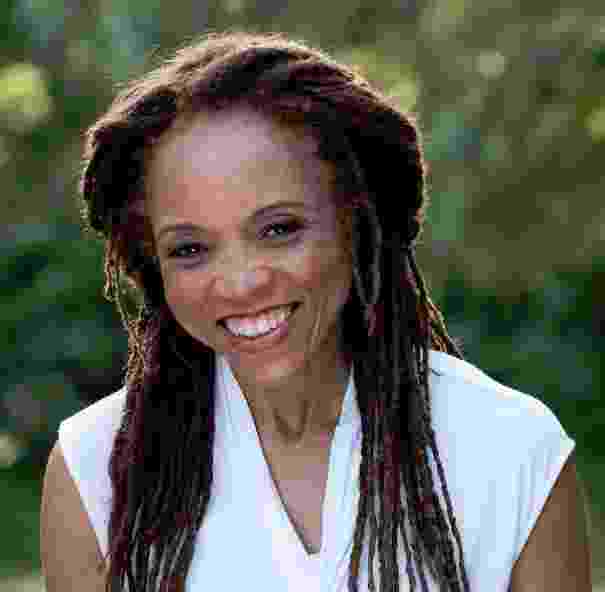 Sophfronia Scott - Uncovering a Hidden Wholeness: The Essence of Unity and Thomas Merton’s Hope for the Human Race, presented for the 16th Annual Thomas Merton Black History Month Lecture, taped live February 22, 2022 at Bellarmine University.
Sophfronia Scott - Uncovering a Hidden Wholeness: The Essence of Unity and Thomas Merton’s Hope for the Human Race, presented for the 16th Annual Thomas Merton Black History Month Lecture, taped live February 22, 2022 at Bellarmine University. NOTE: The transcription of the audio recording was computer generated. Some mistakes were corrected but compare any quoted text to the audio recording to ensure accuracy.
-
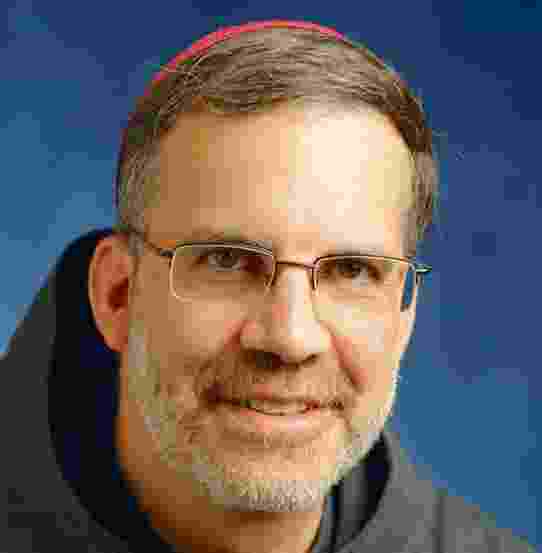 Bishop John Stowe - Fratelli Tutti, Brothers and Sisters All: Pope Francis and Thomas Merton on Universal Fraternity, presented for the 19th Annual Thomas Merton Black History Month Lecture, taped live February 25, 2025 at Bellarmine University.
Bishop John Stowe - Fratelli Tutti, Brothers and Sisters All: Pope Francis and Thomas Merton on Universal Fraternity, presented for the 19th Annual Thomas Merton Black History Month Lecture, taped live February 25, 2025 at Bellarmine University. NOTE: The transcription of the audio recording was computer generated. Some mistakes were corrected but compare any quoted text to the audio recording to ensure accuracy.
-
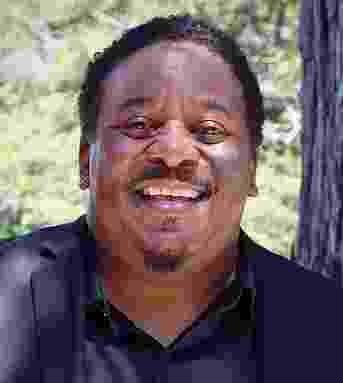 Raymond Carr - Thelonious and the Monk: The Musicality of Thomas Merton and its Meaning for our Moment, presented for the 18th Annual Thomas Merton Black History Month Lecture, taped live February 20, 2024 at Bellarmine University.
Raymond Carr - Thelonious and the Monk: The Musicality of Thomas Merton and its Meaning for our Moment, presented for the 18th Annual Thomas Merton Black History Month Lecture, taped live February 20, 2024 at Bellarmine University. NOTE: The transcription of the audio recording was computer generated. Some mistakes were corrected but compare any quoted text to the audio recording to ensure accuracy.
-
 1965-08-11: Letter from Dorothy Day to Thomas Merton
1965-08-11: Letter from Dorothy Day to Thomas Merton A handwritten letter, signed by Dorothy Day and address to Merton. She discusses the success of the PAX organization weekend [PAX was founded as a U.S. branch of Pax Christi International, a Catholic peace organization, and the national branch is known today as Pax Christi, U.S.A.]. Jim Douglass and Day to go to Rome to confront bishops directly on peacemaking work. She also mentions the good work of Jim Douglass, Jim Forest, Tom Cornell, Howard Everngam, and Eileen Egan in promoting non-violence and building movements.
-
 Craig A. Ford, Jr. - Thomas Merton’s Letters to a White Liberal, In A Black Queer Key, presented for the 17th Annual Thomas Merton Black History Month Lecture, taped live February 21, 2023 at Bellarmine University.
Craig A. Ford, Jr. - Thomas Merton’s Letters to a White Liberal, In A Black Queer Key, presented for the 17th Annual Thomas Merton Black History Month Lecture, taped live February 21, 2023 at Bellarmine University. NOTE: The transcription of the audio recording was computer generated. Some mistakes were corrected but compare any quoted text to the audio recording to ensure accuracy.
-
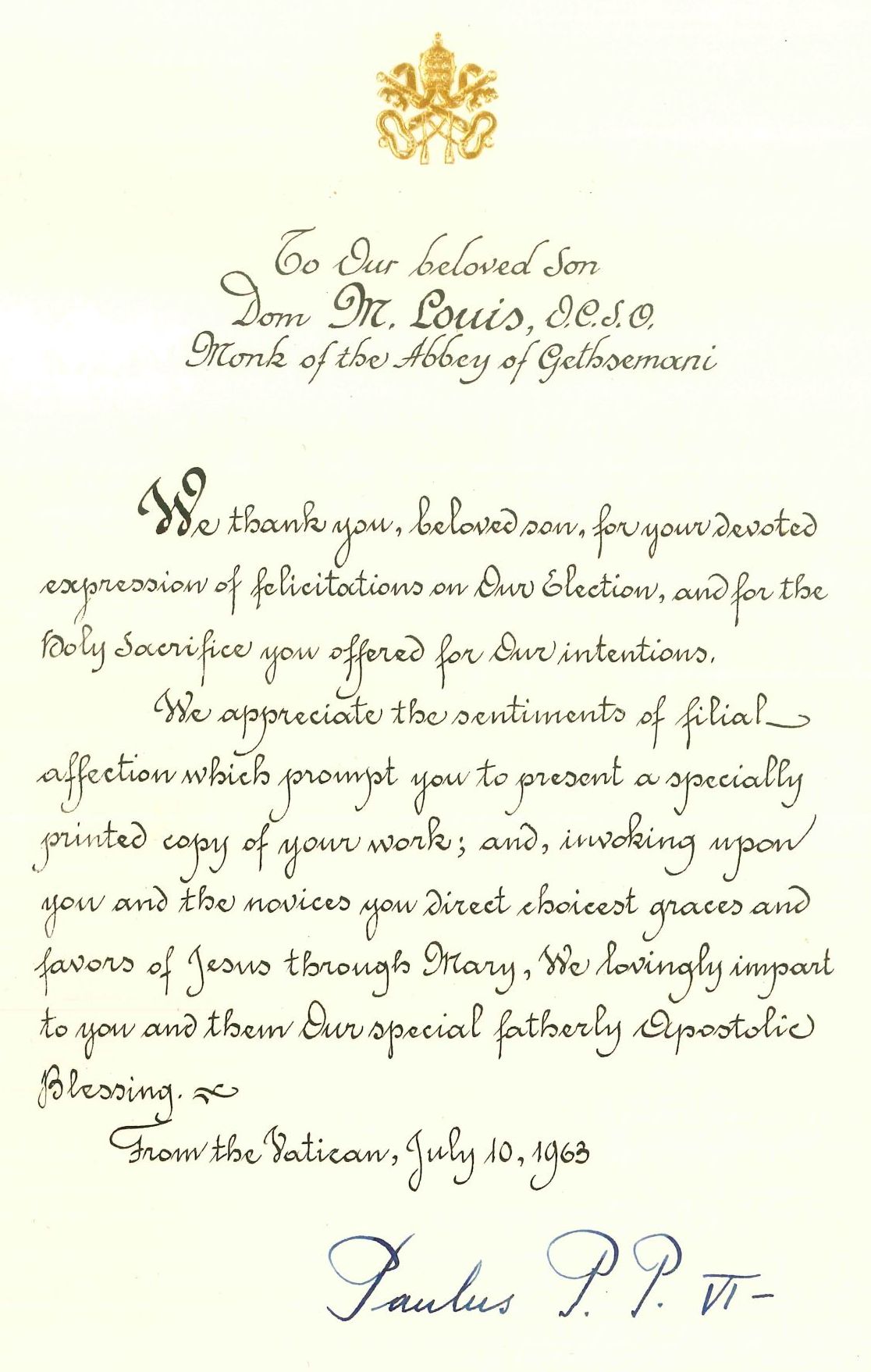 1968-07-10: Letter from Pope Paul VI to Thomas Merton
1968-07-10: Letter from Pope Paul VI to Thomas Merton Pope Paul VI sends Thomas Merton a formal letter of gratitude acknowledging Merton's letter of congratulations and the masses offered for the Pope's intentions.
-
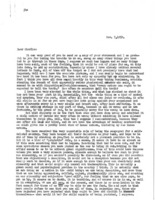 1959-11-07: Letter from Merton to "Van Doren, Charles Lincoln."
1959-11-07: Letter from Merton to "Van Doren, Charles Lincoln."
-
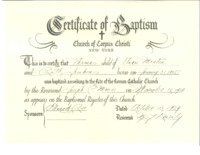 Certificate of the baptism of Thomas Merton (baptism: November 16, 1938; and certificate issued October 13, 1939) at Corpus Christi Catholic Church, New York
Certificate of the baptism of Thomas Merton (baptism: November 16, 1938; and certificate issued October 13, 1939) at Corpus Christi Catholic Church, New York The certificate states that Thomas Merton was baptized by Fr. Joseph Moone at Corpus Christi parish. His baptismal sponsor was Edward Rice. Fr. Kenealy of Corpus Christi issued the certificate.
-
 Merton Recordings #129 Tr-2 (excerpt from the last 5 minutes: a story from the Christian desert fathers and two Zen stories) - from the Vow of conversion of manners.
Merton Recordings #129 Tr-2 (excerpt from the last 5 minutes: a story from the Christian desert fathers and two Zen stories) - from the Vow of conversion of manners.
-
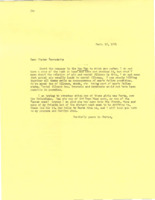 1964-09-16: Letter from Merton to "Bernadette, Sr."
1964-09-16: Letter from Merton to "Bernadette, Sr." The letter discusses the meaning of the "sin and mental illness" in Merton's book «The New Man» (specifically, the third paragraph of Section 136). Merton explains that he is not suggesting that "actual sin usually leads to mental illness", but rather that all illness and death stem from the fallen human condition.
 Sophfronia Scott - Uncovering a Hidden Wholeness: The Essence of Unity and Thomas Merton’s Hope for the Human Race, presented for the 16th Annual Thomas Merton Black History Month Lecture, taped live February 22, 2022 at Bellarmine University. NOTE: The transcription of the audio recording was computer generated. Some mistakes were corrected but compare any quoted text to the audio recording to ensure accuracy.
Sophfronia Scott - Uncovering a Hidden Wholeness: The Essence of Unity and Thomas Merton’s Hope for the Human Race, presented for the 16th Annual Thomas Merton Black History Month Lecture, taped live February 22, 2022 at Bellarmine University. NOTE: The transcription of the audio recording was computer generated. Some mistakes were corrected but compare any quoted text to the audio recording to ensure accuracy. Bishop John Stowe - Fratelli Tutti, Brothers and Sisters All: Pope Francis and Thomas Merton on Universal Fraternity, presented for the 19th Annual Thomas Merton Black History Month Lecture, taped live February 25, 2025 at Bellarmine University. NOTE: The transcription of the audio recording was computer generated. Some mistakes were corrected but compare any quoted text to the audio recording to ensure accuracy.
Bishop John Stowe - Fratelli Tutti, Brothers and Sisters All: Pope Francis and Thomas Merton on Universal Fraternity, presented for the 19th Annual Thomas Merton Black History Month Lecture, taped live February 25, 2025 at Bellarmine University. NOTE: The transcription of the audio recording was computer generated. Some mistakes were corrected but compare any quoted text to the audio recording to ensure accuracy. Raymond Carr - Thelonious and the Monk: The Musicality of Thomas Merton and its Meaning for our Moment, presented for the 18th Annual Thomas Merton Black History Month Lecture, taped live February 20, 2024 at Bellarmine University. NOTE: The transcription of the audio recording was computer generated. Some mistakes were corrected but compare any quoted text to the audio recording to ensure accuracy.
Raymond Carr - Thelonious and the Monk: The Musicality of Thomas Merton and its Meaning for our Moment, presented for the 18th Annual Thomas Merton Black History Month Lecture, taped live February 20, 2024 at Bellarmine University. NOTE: The transcription of the audio recording was computer generated. Some mistakes were corrected but compare any quoted text to the audio recording to ensure accuracy. 1965-08-11: Letter from Dorothy Day to Thomas Merton A handwritten letter, signed by Dorothy Day and address to Merton. She discusses the success of the PAX organization weekend [PAX was founded as a U.S. branch of Pax Christi International, a Catholic peace organization, and the national branch is known today as Pax Christi, U.S.A.]. Jim Douglass and Day to go to Rome to confront bishops directly on peacemaking work. She also mentions the good work of Jim Douglass, Jim Forest, Tom Cornell, Howard Everngam, and Eileen Egan in promoting non-violence and building movements.
1965-08-11: Letter from Dorothy Day to Thomas Merton A handwritten letter, signed by Dorothy Day and address to Merton. She discusses the success of the PAX organization weekend [PAX was founded as a U.S. branch of Pax Christi International, a Catholic peace organization, and the national branch is known today as Pax Christi, U.S.A.]. Jim Douglass and Day to go to Rome to confront bishops directly on peacemaking work. She also mentions the good work of Jim Douglass, Jim Forest, Tom Cornell, Howard Everngam, and Eileen Egan in promoting non-violence and building movements. Craig A. Ford, Jr. - Thomas Merton’s Letters to a White Liberal, In A Black Queer Key, presented for the 17th Annual Thomas Merton Black History Month Lecture, taped live February 21, 2023 at Bellarmine University. NOTE: The transcription of the audio recording was computer generated. Some mistakes were corrected but compare any quoted text to the audio recording to ensure accuracy.
Craig A. Ford, Jr. - Thomas Merton’s Letters to a White Liberal, In A Black Queer Key, presented for the 17th Annual Thomas Merton Black History Month Lecture, taped live February 21, 2023 at Bellarmine University. NOTE: The transcription of the audio recording was computer generated. Some mistakes were corrected but compare any quoted text to the audio recording to ensure accuracy. 1968-07-10: Letter from Pope Paul VI to Thomas Merton Pope Paul VI sends Thomas Merton a formal letter of gratitude acknowledging Merton's letter of congratulations and the masses offered for the Pope's intentions.
1968-07-10: Letter from Pope Paul VI to Thomas Merton Pope Paul VI sends Thomas Merton a formal letter of gratitude acknowledging Merton's letter of congratulations and the masses offered for the Pope's intentions. 1959-11-07: Letter from Merton to "Van Doren, Charles Lincoln."
1959-11-07: Letter from Merton to "Van Doren, Charles Lincoln."  Certificate of the baptism of Thomas Merton (baptism: November 16, 1938; and certificate issued October 13, 1939) at Corpus Christi Catholic Church, New York The certificate states that Thomas Merton was baptized by Fr. Joseph Moone at Corpus Christi parish. His baptismal sponsor was Edward Rice. Fr. Kenealy of Corpus Christi issued the certificate.
Certificate of the baptism of Thomas Merton (baptism: November 16, 1938; and certificate issued October 13, 1939) at Corpus Christi Catholic Church, New York The certificate states that Thomas Merton was baptized by Fr. Joseph Moone at Corpus Christi parish. His baptismal sponsor was Edward Rice. Fr. Kenealy of Corpus Christi issued the certificate. Merton Recordings #129 Tr-2 (excerpt from the last 5 minutes: a story from the Christian desert fathers and two Zen stories) - from the Vow of conversion of manners.
Merton Recordings #129 Tr-2 (excerpt from the last 5 minutes: a story from the Christian desert fathers and two Zen stories) - from the Vow of conversion of manners.  1964-09-16: Letter from Merton to "Bernadette, Sr." The letter discusses the meaning of the "sin and mental illness" in Merton's book «The New Man» (specifically, the third paragraph of Section 136). Merton explains that he is not suggesting that "actual sin usually leads to mental illness", but rather that all illness and death stem from the fallen human condition.
1964-09-16: Letter from Merton to "Bernadette, Sr." The letter discusses the meaning of the "sin and mental illness" in Merton's book «The New Man» (specifically, the third paragraph of Section 136). Merton explains that he is not suggesting that "actual sin usually leads to mental illness", but rather that all illness and death stem from the fallen human condition.